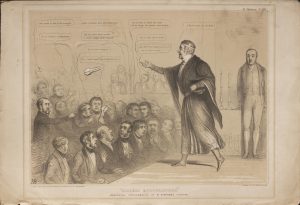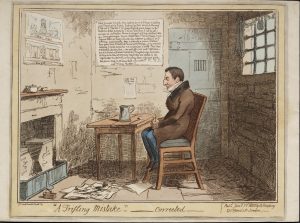The Watkinson has a great variety of historical books, records, photos, prints and more. While working in the Watkinson, I have been introduced to the many ways history is recorded. Most recently I organized a collection of British caricatures. The collection contains around 190 prints with ranging topics, but a majority are political and social satire. The popularity of these prints and the impact they had on British society made me want to research more about the evolution of printmaking and why these prints were so important.
The reign of King George III from 1760 to 1820 marked a time of ideological revolution and the rise in satirical prints. The mass production of prints allowed for information to be accessed by the ordinary person, who was most likely illiterate. British satirical caricatures were used to criticize certain political decisions or platforms of political parties in particular the Whig and Tory parties. Prints created in the 18th century use the technique of physiognomy, which is the judging of a person’s character from the depiction of their physical features. These prints have grotesque and distorted images of various politicians, but mainly Charles James Fox (Whig Party), William Pitt the Younger (Tory Party), King George III and Napoleon.

A famous printmaker, Isaac Cruikshank, depicts Charles James Fox as a French Revolution sympathizer in his print “A Right Honorable Alias Sans Culotte” which is one of the prints in the collection at the Watkinson. This print contains Fox split into two different outfits. As the spectator of the print, on the right side, Fox is dressed neatly in English clothing singing “God Save Great George our king.” On the left side, Fox is dressed as a French revolutionary in ragged, torn clothes with a bludgeon singing, “Ca ira, ca ira, ca ira,” an emblematic song of the French Revolution. Images such as these were used to ridicule politicians. Some victims of the political satires, like Fox, would buy entire editions or even bribe publishers to stop printing these satirical images in order to maintain a positive public image.
As printing and satire evolved, there was a shift in technique. Around 1820 the grotesque satirical style was phased out and a newer more genteel trend became popular. John Doyle, a famous printmaker who published his work under the initials HB, was known for his mild satire with more naturalistic depictions of political figures. The collection in the Watkinson contains thirty of John Doyle’s prints. Grotesque satirical prints were replaced with comic prints that were made more for family consumption. With the popularization of newspapers and magazines the number of singly published sheets rapidly declined.
In the Watkinson, the prints are mostly from the 1800s. Some of the early prints show the characteristic grotesque form of satire, but most of the prints are more realistic in their depiction of politicians. While processing these prints, I learned a lot about the political scene in Britain at the time. As time passed the literacy rates in Britain rose, which is evident from the later prints in the collection at the Watkinson. Earlier prints do not have much text other than the titles, but speech bubbles and small captions can be seen in the later prints. This shows just how influential the mass production of prints was and how the prints reflect British society in the time period during which they were published.
Just like the Currier and Ives prints that I worked on in January, these prints are both historical in content and historical in creation. Prints are a great way of interpreting history since there is much more behind them than what is seen on the page. The British print collection at the Watkinson is definitely a reason to stop by!
Posted by Student Assistant Meg Huston (2020)
Bibliography
Bury, Stephen J., and Andrew W. Mellon. “British Visual Satire, 18th–20th Centuries.” Oxford Art Online, http://www.oxfordartonline.com/page/british-visual-satire-18th-20th-centuries. Accessed 25 Apr. 2018.
Donald, Diana. The Age of Caricature: Satirical Prints in the Reign of George III. Published for the Paul Mellon Centre for Studies in British Art by Yale University Press, 1996.
George, Mary Dorothy. Catalogue of Political and Personal Satires. The Trustees of the British Museum, 1978.
Tags: British caricatures, British prints, Images

